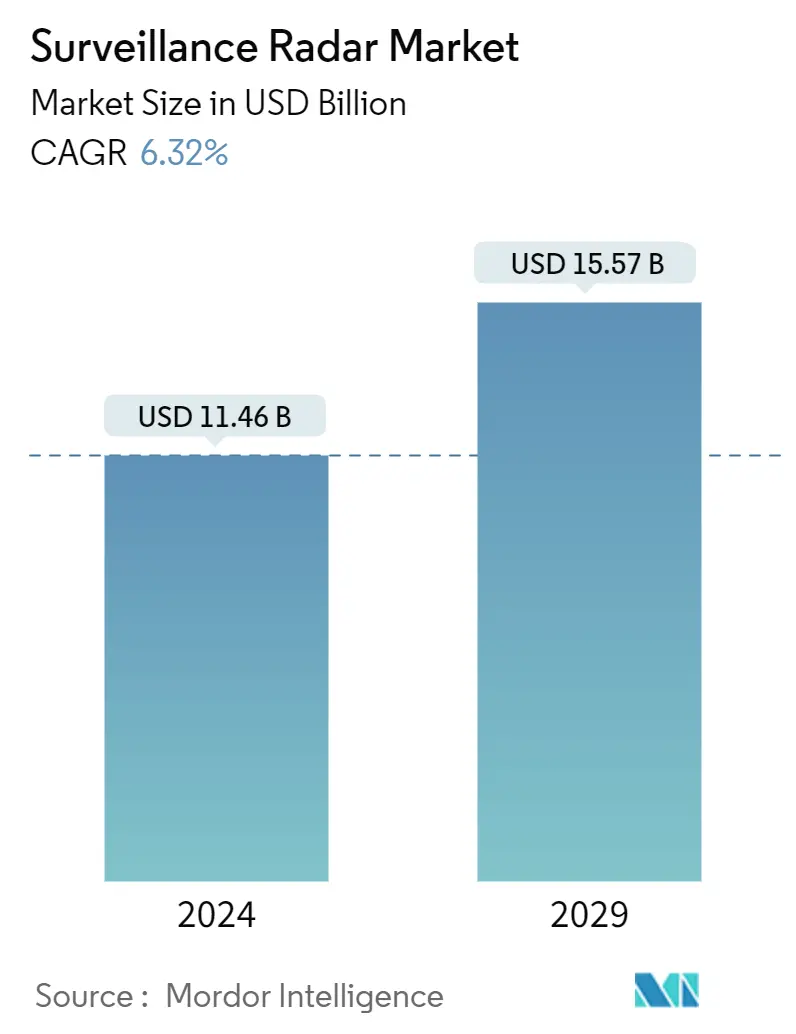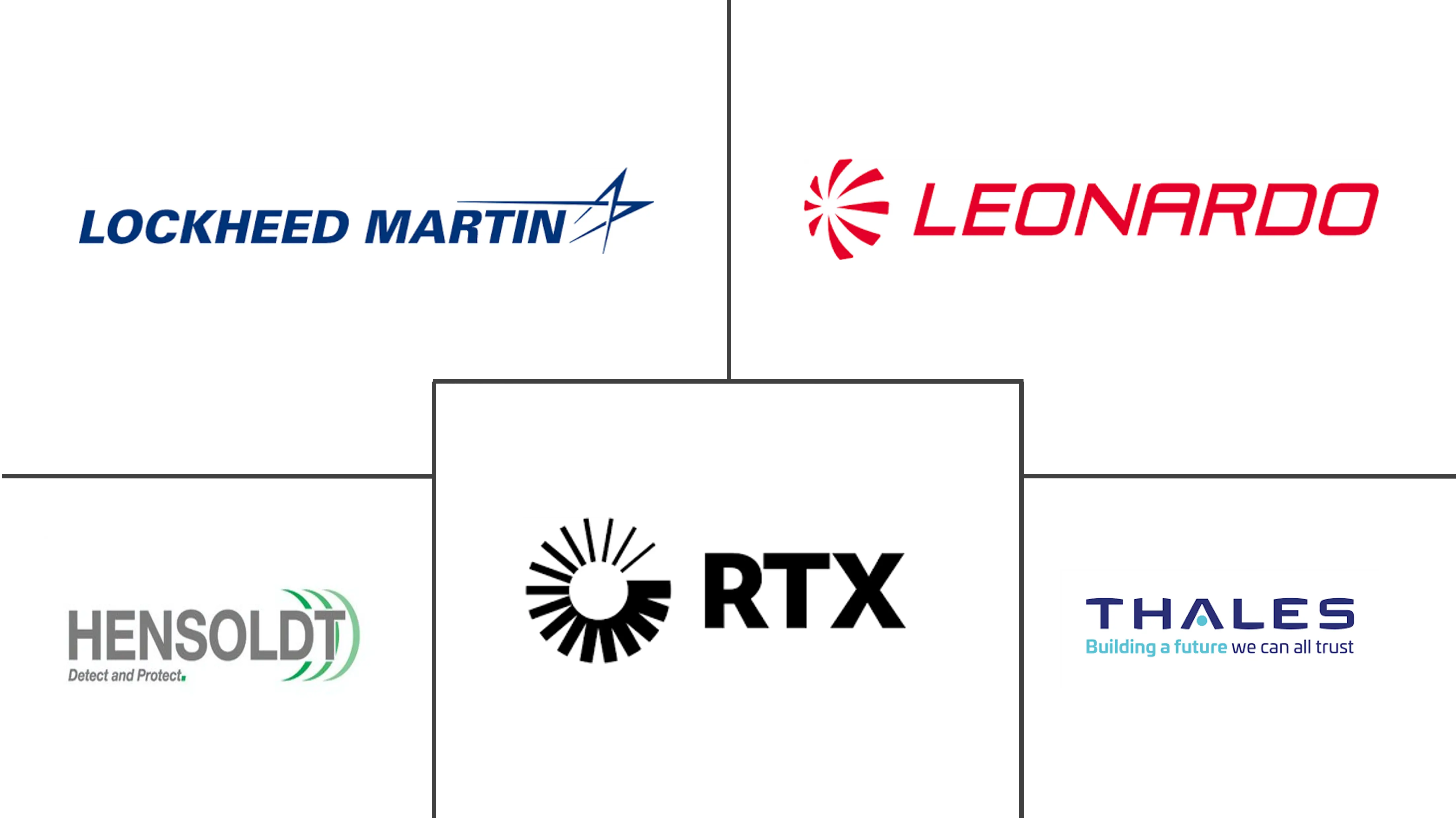Market Size of Surveillance Radar Industry

| Study Period | 2019 - 2029 |
| Market Size (2024) | USD 11.46 Billion |
| Market Size (2029) | USD 15.57 Billion |
| CAGR (2024 - 2029) | 6.32 % |
| Fastest Growing Market | Asia Pacific |
| Largest Market | North America |
| Market Concentration | Low |
Major Players
*Disclaimer: Major Players sorted in no particular order |
Surveillance Radar Market Analysis
The Surveillance Radar Market size is estimated at USD 11.46 billion in 2024, and is expected to reach USD 15.57 billion by 2029, growing at a CAGR of 6.32% during the forecast period (2024-2029).
The investments in airport surveillance infrastructure by the government and airport operators for complications, like drone intrusion into the airspace, are expected to propel the demand for the surveillance radar market during the forecast period. The need to strengthen border security and the growing threat of missiles are generating the need for advanced radar systems. The principal manufacturers are heavily investing in radar technology to improve the operating range and detection capabilities. The surveillance radar segment is witnessing several innovations, such as the incorporation of 3D technology, augmented reality for better situational awareness, etc. The advancement in radar technology is anticipated to bolster the sales of surveillance radars in the coming future.
The surge in military modernization initiatives plays a pivotal role in driving the market for Surveillance radars. As nations prioritize upgrading their defense capabilities, surveillance emerges as an integral component of comprehensive defense modernization programs. The incorporation of state-of-the-art radar systems aligns with broader military strategies, contributing to sustained demand in the market.
Similarly, the rapid development of aviation infrastructure in developing economies, such as India and China, due to the increased air traffic that resulted from a rising standard of living and low airfares, is propelling the airport and runway development and, subsequently, the market for airport radar systems. Moreover, the increasing investments by OEMs to develop new and advanced radar systems for surveillance (counter-stealth technologies) are anticipated to bolster the growth of the market in the coming future.
There is a significant opportunity for OEMs in the development of multi-function radar systems that offer enhanced capabilities, such as simultaneous surveillance, tracking, and target identification. Additionally, the rapid adoption of unmanned aerial vehicles (UAVs) for military and civilian applications presents a growing market for radar systems that are tailored to detect aerial threats.
However, the surveillance radar market faces few restraints that could impact the growth over the forecast period. Primary restraint is the high cost associated with developing and deploying radar systems, particularly for countries with limited defense budgets. Moreover, stringent export controls on radar technology pose challenges for market players looking to expand their global footprint.
Surveillance Radar Industry Segmentation
Surveillance radars are used to monitor various activities across critical infrastructure and installations such as airports, camps, borders, and harbors. These radars are utilized to detect and track non-linearly and non-cooperatively, as well as moving targets for national security.
The surveillance radar market is segmented by platform, components, and application. By platform, the market is segmented into airborne, land, sea, and space. By application, the market is classified into commercial and military. Based on components, the market is segmented into antennas, transmitters, power amplifiers, receivers, duplexers, digital signal processors, and other components. The report also covers the market sizes and forecasts for the surveillance radar market in major countries across different regions (North America, Europe, Asia-Pacific, Latin America, and the Middle East and Africa).
For each segment, the market size is provided in terms of value (USD).
| Platform | |
| Airborne | |
| Land | |
| Sea | |
| Space |
| Component | |
| Antennas | |
| Transmitters | |
| Duplexers | |
| Power Amplifiers | |
| Receivers | |
| Digital Signal Processors | |
| Other components |
| Application | |
| Commercial | |
| Military |
| Geography | |||||||
| |||||||
| |||||||
| |||||||
| |||||||
|
Surveillance Radar Market Size Summary
The surveillance radar market is poised for significant growth, driven by increasing investments in defense and aviation infrastructure. Governments and airport operators are enhancing airport surveillance systems to address challenges such as drone intrusions, while the need for advanced radar systems is rising due to border security concerns and missile threats. Manufacturers are investing heavily in radar technology advancements, including 3D technology and augmented reality, to improve detection capabilities. The market is further bolstered by military modernization initiatives, as nations prioritize upgrading defense capabilities, making surveillance radars a critical component of these strategies. The rapid development of aviation infrastructure in emerging economies, coupled with the growing adoption of unmanned aerial vehicles, presents additional opportunities for market expansion.
Despite the promising growth prospects, the surveillance radar market faces challenges such as high development costs and stringent export controls, which could hinder expansion efforts. However, increasing military expenditure driven by global geopolitical tensions is fueling demand for surveillance radars in both law enforcement and military applications. The Asia Pacific region is expected to experience remarkable growth due to rising defense expenditures and the procurement of next-generation military radars by countries like China, India, and South Korea. The market is highly competitive, with major players like Lockheed Martin, THALES, and HENSOLDT AG catering to both military and commercial applications. Companies are focusing on research and development to create advanced radar systems and expand into new regions, while the trend towards indigenization is expected to enhance market competitiveness.
Surveillance Radar Market Size - Table of Contents
-
1. MARKET DYNAMICS
-
1.1 Market Overview
-
1.2 Market Drivers
-
1.3 Market Restraints
-
1.4 Porter's Five Forces Analysis
-
1.4.1 Bargaining Power of Suppliers
-
1.4.2 Bargaining Power of Buyers/Consumers
-
1.4.3 Threat of New Entrants
-
1.4.4 Threat of Substitute Products
-
1.4.5 Intensity of Competitive Rivalry
-
-
-
2. MARKET SEGMENTATION
-
2.1 Platform
-
2.1.1 Airborne
-
2.1.2 Land
-
2.1.3 Sea
-
2.1.4 Space
-
-
2.2 Component
-
2.2.1 Antennas
-
2.2.2 Transmitters
-
2.2.3 Duplexers
-
2.2.4 Power Amplifiers
-
2.2.5 Receivers
-
2.2.6 Digital Signal Processors
-
2.2.7 Other components
-
-
2.3 Application
-
2.3.1 Commercial
-
2.3.2 Military
-
-
2.4 Geography
-
2.4.1 North America
-
2.4.1.1 United States
-
2.4.1.2 Canada
-
-
2.4.2 Europe
-
2.4.2.1 United Kingdom
-
2.4.2.2 Germany
-
2.4.2.3 France
-
2.4.2.4 Russia
-
2.4.2.5 Rest of Europe
-
-
2.4.3 Asia-Pacific
-
2.4.3.1 China
-
2.4.3.2 Japan
-
2.4.3.3 India
-
2.4.3.4 South Korea
-
2.4.3.5 Rest of Asia-Pacific
-
-
2.4.4 Latin America
-
2.4.4.1 Brazil
-
2.4.4.2 Rest of Latin America
-
-
2.4.5 Middle-East and Africa
-
2.4.5.1 United Arab Emirates
-
2.4.5.2 Saudi Arabia
-
2.4.5.3 Egypt
-
2.4.5.4 Rest of Middle-East and Africa
-
-
-
Surveillance Radar Market Size FAQs
How big is the Surveillance Radar Market?
The Surveillance Radar Market size is expected to reach USD 11.46 billion in 2024 and grow at a CAGR of 6.32% to reach USD 15.57 billion by 2029.
What is the current Surveillance Radar Market size?
In 2024, the Surveillance Radar Market size is expected to reach USD 11.46 billion.

